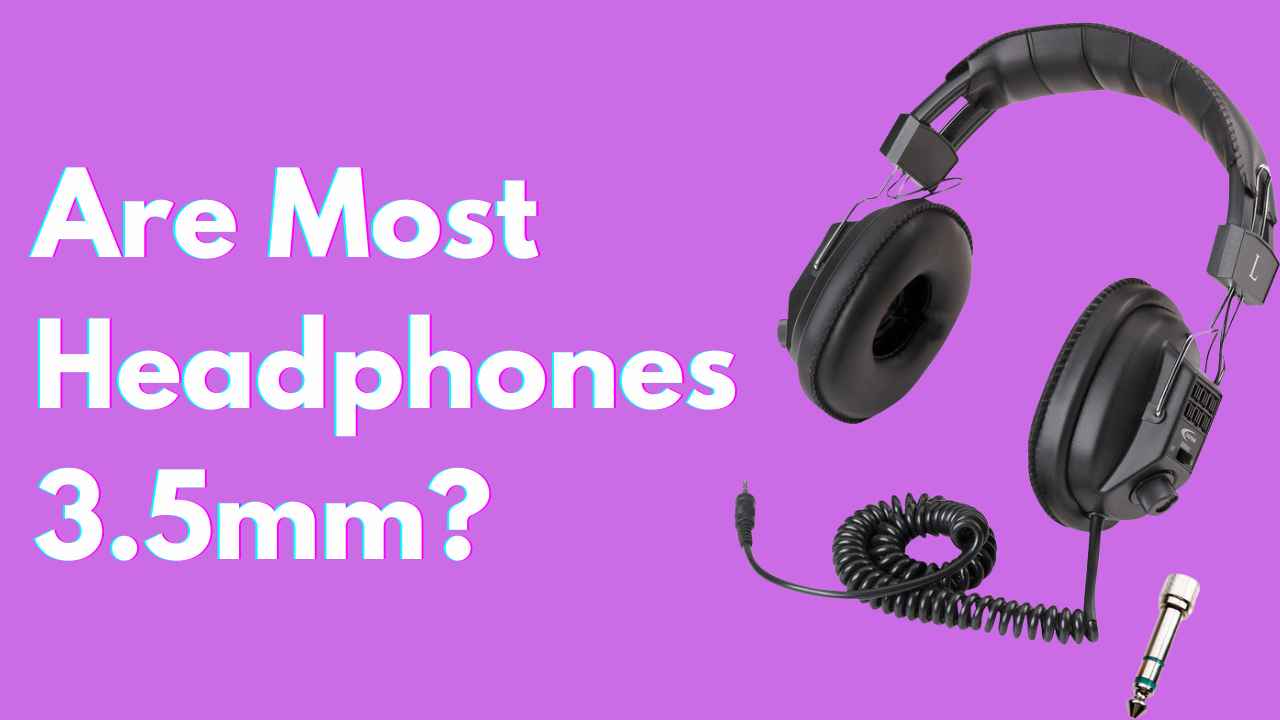Most headphones use a 3.5mm connector, which has been the standard for years. It’s compatible with smartphones, laptops, audio players, and gaming consoles.
However, newer models may not have this connector due to wireless tech and USB-C ports. Despite these advancements, the 3.5mm headphone jack is still common in many devices.
History and Origin of 3.5mm Headphones
The 3.5mm headphone jack, also known as a mini jack, has a fascinating history. It originated in the 19th century as the 6.35mm jack for telephone switchboards.
However, it was too big for portable devices. In the 1950s, the 3.5mm jack was introduced as a smaller version for transistor radios’ earpieces.
It gained popularity in the 1960s with portable FM radios and became a standard connector for headphones with the Sony Walkman in the 1980s.
Since then, it has remained widely used due to its compact size and versatility.
What makes 3.5mm headphones so popular? Advantages
Versatility:
The 3.5mm headphone jack is widely renowned for its exceptional versatility.
It effortlessly connects to a vast array of devices, including but not limited to smartphones, laptops, audio players, tablets, gaming consoles, and even some professional audio equipment.
With its universal compatibility, it provides seamless audio connectivity across various platforms and devices.
Durability:
One of the notable strengths of the 3.5mm headphone jack is its remarkable durability.
Designed to endure countless plug-ins and unpluggings, it withstands the test of time and maintains its functionality without easily wearing out.
This robustness ensures a reliable and long-lasting audio connection, making it a preferred choice for individuals who prioritize durability in their audio accessories.
Superior Audio Quality:
Wired headphones with a 3.5mm connector offer purists and audiophiles an unmatched audio experience.
They provide high-fidelity sound reproduction and preserve the original audio source’s nuances.
This exceptional audio quality creates a more immersive listening experience that surpasses most wireless options.
No Battery Requirement:
The 3.5mm headphones don’t need batteries; they use the device’s power.
No worries about charging or battery life! Enjoy music on your phone or watch a movie on your laptop with uninterrupted audio.
Battery levels? Forget about them!
Cost-Effective:
The 3.5mm headphones are known for their remarkable features and cost-effectiveness.
They are more affordable compared to wireless or USB-C headphones, making them a budget-friendly choice for many users.
With these headphones, users can enjoy high-quality audio without spending too much.
Ease of Use:
The plug-and-play nature of the 3.5mm headphone jack makes it incredibly user-friendly.
With a simple connection, you can instantly enjoy your favorite audio content without the need for complex pairing processes or dealing with signal interruptions.
This hassle-free experience enhances convenience and ensures a seamless audio connection.
Universally Recognized Standard:
The 3.5mm headphone jack is a widely recognized and accepted standard. It is found in many devices and industries, making it easy for users to find compatible headphones and enjoy hassle-free audio connectivity.
Its long history and widespread adoption have solidified its popularity worldwide.
Disadvantages of 3.5mm Headphones
The disadvantages of 3.5mm headphones compared to other types of headphones depend on the specific type of headphone being compared.
However, some general disadvantages of 3.5mm headphones include:
Audio quality:
The audio quality of 3.5mm headphones depends on the device’s sound card, which might not be ideal for gaming.
This can result in lower quality audio compared to other types of headphones.
Interference:
3.5mm headphones are more susceptible to interference, which can degrade audio quality.
This can be a problem in noisy environments or when using the headphones near other electronic devices.
Limited features:
3.5mm headphones typically lack advanced features like surround sound and active noise cancellatio.
This can be a disadvantage for users who want a more immersive audio experience.
Compatibility:
While 3.5mm headphones are compatible with a wide range of devices, some newer devices are phasing out the 3.5mm jack in favor of USB or wireless connections. This can limit the compatibility of 3.5mm headphones with newer devices.
Cable management:
Wired 3.5mm headphones require a cable to connect to the device, which can be cumbersome and prone to tangling.
This can be a disadvantage for users who want a more streamlined audio experience.
It’s important to note that the disadvantages of 3.5mm headphones are not universal and depend on the specific use case and device being used.
Additionally, 3.5mm headphones still offer many advantages over other types of headphones, such as versatility and affordability.
How do I know if my headphones are 3.5 mm?
Determining if your headphones utilize a 3.5mm connector is usually a straightforward process. Here are some simple ways to ascertain the type of connector your headphones have.
Check the Product Specifications
The easiest way to identify whether your headphones are 3.5mm is to check the product specifications.
These can often be found on the packaging, in the product manual, or on the manufacturer’s website.
Look for details about the headphones’ connector or plug type, which should specify the size.
Compare with Known 3.5mm Connectors
If you can’t find the specifications or the manual is unavailable, you can compare the headphone connector to known 3.5mm connectors.
Most smartphone earphones use a 3.5mm connector. So, just compare your headphones’ plug to the plug on a pair of earphones that you know have a 3.5mm connector.
Use a Ruler or Measuring Tool
If you’re unsure, you can measure the diameter of the headphone connector directly with a ruler or digital caliper if you have one.
A 3.5mm connector, as the name suggests, has a diameter of 3.5mm. Keep in mind that using a standard ruler may not provide accurate measurements due to the small size of the connector.
By following these steps, you should be able to determine whether your headphones use a 3.5mm connector.
Difference between 2.5mm and 3.5mm Headphone Jacks
Size:
The primary difference between the 2.5mm and 3.5mm headphone jacks is the size. The numbers 2.5 and 3.5 refer to the diameter of the plug. The 2.5mm jack is smaller than the 3.5mm jack.
Compatibility:
The 3.5mm headphone jack is the most common and is found on most headphones, smartphones, laptops, and audio players.
The 2.5mm jack, while less common, is often found on some models of cordless phones and two-way radios.
Audio Quality:
Both 2.5mm and 3.5mm headphone jacks are capable of delivering high-quality audio.
However, the 3.5mm jack is more commonly associated with superior audio performance because it is often used with higher-end audio devices.
Durability:
3.5mm jacks are generally more robust and durable compared to 2.5mm jacks, given their larger size.
Adapters:
Since most devices are equipped with a 3.5mm audio port, 2.5mm headphones often require an adapter to be compatible with these devices.
Usage:
2.5mm jacks were commonly used in older mobile devices and some professional audio equipment, while 3.5mm jacks have become a standard for most consumer electronic devices.
Which Headphones Use 3.5mm?
A wide range of headphones use the 3.5mm headphone jack due to its universal compatibility, high quality audio, and ease of use. Some of these include:
Over-Ear Headphones:
Also known as around-ear or full-size headphones, these are typically the largest headphones, encasing the entire ear within their padding.
Popular brands like Audio-Technica, Sennheiser, and Beoplay offer models that utilize 3.5mm connectors.
On-Ear Headphones:
These headphones rest on the outer ear but don’t entirely encase it. Brands like Grado, Koss, and Beats have models that employ the 3.5mm headphone jack.
In-Ear Headphones:
Also known as earbuds or in-ear monitors (IEMs), these headphones fit directly into the ear canal.
Well-known audio companies such as Sony, JBL, and Bose have various models using the 3.5mm connector.
Gaming Headsets:
Many gaming headsets also utilize the 3.5mm connector, allowing compatibility with various gaming consoles and computers.
Brands such as HyperX, Razer, and Turtle Beach produce gaming headsets with 3.5mm jacks.
It’s important to note that while these headphones typically include a 3.5mm connector, they may also come with additional adapters for increased compatibility with other devices.
Conclusion:
To sum up, the 3.5mm headphone jack is a reliable and versatile audio connector. It works with various devices like over-ear headphones, in-ear monitors, and gaming headsets.
Despite the rise of other audio technologies, the 3.5mm jack remains popular due to its user-friendly nature and affordability.
Whether you’re an audiophile or a casual listener, 3.5mm headphones are a trustworthy option for great sound quality and convenience.




One Comment on “Are Most Headphones 3.5mm?”
Comments are closed.